

Abstract
The CAPE-OPEN tools under discussion more precisely refer to the use of COCO simulator, Scilab Thermo Import and Scilab Unit Operation and how these have been used in the calculation in aspects of various projects within the research groups at UCT.
The limitations to further investment in FT technology is the cost of the ASU. The use of air in the reformers is viable but produced a FT feed stream that is high in N2. The separation of N2 from syngas is not viable and it will need to be part of the syngas recycle stream. This increases the cost of the recycle and since N2 is not consumed, its concentrations will be elevated and require the addition of a purge stream. Current trends in FT technology is to target high CO conversion once through FT reaction systems in the presence of N2. COCO was used to develop a preliminary automated simulation of the FT feed preparation and FT reactor recycle system.
The Carbon black process is used to make large volumes of high grade carbon for tyre manufacture from a naphthalene rich feed. The reaction system consists of 4 parts, a feed pre-heater in which partial combustion of the feed yields the required reaction temperatures, followed by a feed reduction step making solid carbon and gases, a water quench and a product gas cooler that preheats the reactor feed air. As a preliminary estimate, Gibbs reactors can be used to estimate temperatures and carbon formation from the first two stages. Both COCO and Scilab’s IPOpt with the ScilabThermoImport have been used to make these estimates. Modifications are made to the Gibbs minimisation procedure to yield solid carbon.
Mozambique has vast natural gas resources and currently export large volumes of natural gas. Two projects are looking at developing local technology for natural gas processing. Project one considers the energy coupling between an ATR and a steam reformer. A flow sheet is developed with direct energy coupling between the ATR and steam reformer to explore its viability. Project two looks at the conversion of raw natural gas in a Sasol superflex catalytic cracking (SCC) unit. The objective is to study the viability of having an energy self sufficient process. To achieve this, a COCO flow model of the SCC unit is developed that attempts to predict the energy flows and conversions.
